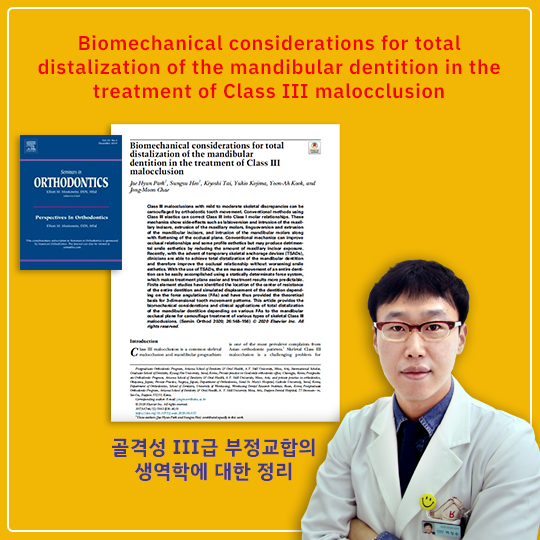게시물 원소스: 굿스마일치과 | 수술을 원치않는 경도에서 중등도의 골격성 제3급 부정교합 환자의 교정치료시 고려해야 할 역학에 대한 연구 | 굿스마일치과교정과치과의원

Biomechanical considerations for total distalization of the mandibular dentition in the treatment of Class III malocclusion
– Jae Hyun Park, Sungsu Heo, Kiyoshi Tai, Yukio Kojima, Yoon-Ah Kook, and Jong-Moon Chae
Biomechanical considerations for total
distalization of the mandibular
dentition in the treatment of Class III
malocclusion
Jae Hyun Park1, Sungsu Heo1, Kiyoshi Tai, Yukio Kojima, Yoon-Ah Kook, and
Jong-Moon Chae
Class III malocclusions with mild to moderate skeletal discrepancies can be
camouflaged by orthodontic tooth movement. Conventional methods using
Class III elastics can correct Class III into Class I molar relationships. These
mechanics show side-effects such as labioversion and intrusion of the maxillary
incisors, extrusion of the maxillary molars, linguoversion and extrusion
of the mandibular incisors, and intrusion of the mandibular molars along
with flattening of the occlusal plane. Conventional mechanics can improve
occlusal relationships and some profile esthetics but may produce detrimental
smile esthetics by reducing the amount of maxillary incisor exposure.
Recently, with the advent of temporary skeletal anchorage devices (TSADs),
clinicians are able to achieve total distalization of the mandibular dentition
and therefore improve the occlusal relationship without worsening smile
esthetics. With the use of TSADs, the en masse movement of an entire dentition
can be easily accomplished using a statically determinate force system,
which makes treatment plans easier and treatment results more predictable.
Finite element studies have identified the location of the center of resistance
of the entire dentition and simulated displacement of the dentition depending
on the force angulations (FAs) and have thus provided the theoretical
basis for 3-dimensional tooth movement patterns. This article provides the
biomechanical considerations and clinical applications of total distalization
of the mandibular dentition depending on various FAs to the mandibular
occlusal plane for camouflage treatment of various types of skeletal Class III
malocclusions. (Semin Orthod 2020; 26:148–156) © 2020 Elsevier Inc. All
rights reserved.